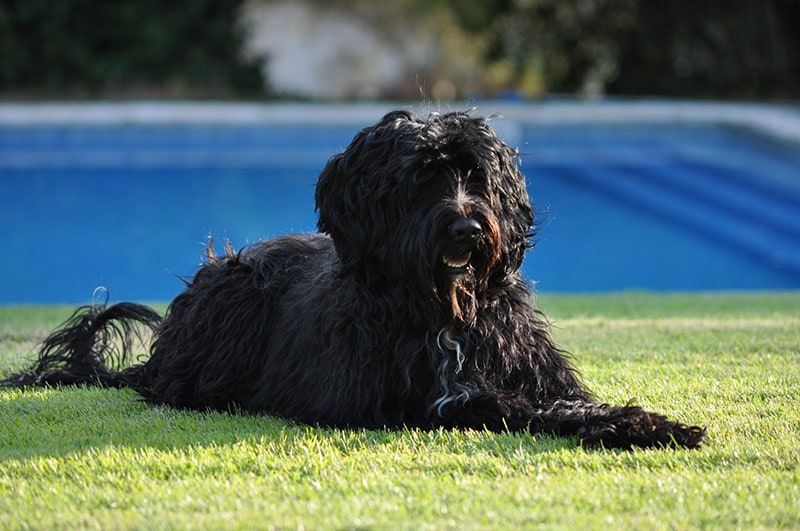- June 9, 2023
Portuguese Water Dog Health Issues: 8 Common Concerns & Treatments


Portuguese Water Dogs make perfect pets due to their affectionate and loveable natures. They are intelligent, friendly, and great around people, making them suitable for all kinds of owners, including singles and families with kids.
These canines are active and agile, which is why they require regular mental and physical stimulation along with proper exercise. They are a generally healthy breed, with their lifespan being between 11 and 13 years. That said, Portuguese Water Dogs are prone to several health issues that you should watch for to ensure that your furry friend will live a long and happy life.
In this article, we’ll talk more about the possible health issues that Portuguese Water Dogs may experience, along with their causes and treatment options.
Let’s jump right in!

The 8 Portuguese Water Dog Health Issues
1. Addison’s Disease (Hypoadrenocorticism)
Portuguese Water Dogs are predisposed to a condition called Addison’s disease (hypoadrenocorticism). It creates a dysfunction of the adrenal glands, causing them to produce corticosteroid hormones, such as cortisol and aldosterone, that affect your dog’s metabolism and stress levels.
The signs of Addison’s disease may vary, often not being visible in canines, and it can resemble various other diseases.
Common signs of this health problem in dogs may include:
- Lethargy
- Decreased appetite
- Diarrhea
- Vomiting
- Abnormal heart rhythms
- Slow heart rate
These signs can vary from dog to dog, and most of the time, they’re not enough to diagnose the disease. Instead, if they suspect that a dog has Addison’s disease, a vet will take blood work tests to find any imbalances in electrolytes in the dog’s blood sample.
Causes:
There are several possible causes for Addison’s disease in dogs, with the two most common ones being:
- Immune-mediated destruction of your dog’s adrenal tissue
- Tumor/defect of the pituitary gland
It’s also possible for dogs to develop Addison’s disease after treatment for Cushing’s disease or treatments that include long-term steroids.
Although this condition can occur in almost any dog, it’s especially common in Portuguese Water Dogs, Great Danes, and Labrador Retrievers.
Treatment Methods:
Most dogs can be successfully treated for Addison’s disease as long as they get a proper diagnosis from a vet. The treatment for this health problem in canines typically includes giving your dog injectable medication known as DOCP (Desoxycorticosterone pivalate). However, this is not suitable for all dogs, which is why some canines may get a prescription for oral medications instead of DOCP.

2. Hypothyroidism
Hypothyroidism occurs when your dog’s thyroid gland is functioning abnormally, leading to the underproduction of thyroid hormones. Those hormones play an important part in your dog’s metabolism; Portuguese Water Dogs suffering from this problem typically have either degeneration or inflammation of this gland.
Due to the nature of this condition, it mostly occurs in older dogs and in medium to large dog breeds.
The clinical signs of hypothyroidism include:
- Lethargy
- Laziness
- Weight gain
- Chronic skin or ear infections
- Increased skin pigmentation
- Dry, brittle hair
- Thinning hair coat
- Inability to regrow hair
- Dry eye
Causes:
In 95% of canines, hypothyroidism occurs due to two other diseases:
- Lymphocytic thyroiditis
- Idiopathic thyroid gland atrophy
In the other 5% of dogs, hypothyroidism can occur due to other health problems, such as thyroid gland cancer. Genetics also plays an important role in the odds of this condition developing, as it’s typically hereditary.
Treatment Methods:
Hyperthyroidism in dogs is treatable but it’s not entirely curable. Your veterinarian will likely prescribe an oral thyroid replacement hormone that your dog needs to intake for life.
Dogs that don’t receive treatment will have a shorter lifespan and may develop other health issues as a side effect.
3. Cataracts
Portuguese Water Dogs are prone to several eye defects, including cataracts, representing an imperfection of the eye lens. The eye lens enables light and images to travel directly to the retina, where vision occurs; although typically clear, this lens can experience a change in clarity or transparency due to the presence of diseases like cataracts.
Cataracts can vary from dog to dog, so the vision of some canines could be drastically impaired while others may only have small vision interferences.
The signs of this eye problem in dogs include:
- Impaired vision
- Bumping into things
- White spot in the middle of the pupil
- Squinting
- Scratching eyes
- Confusion
- Disorientation
- Pain
This condition is often uncomfortable and may eventually lead to blindness, which is why it’s best to consult your vet if you notice any of these signs.
Causes:
Cataracts are hereditary, so genetics is the most common cause of this eye abnormality in dogs. This condition can also occur in dogs with diabetes mellitus.
It can have other causes, including:
- Trauma
- Age
- Low calcium levels in the blood
- Uvea inflammation
- UV light exposure
This condition can progress and lead to blindness, so be sure to react in time to prevent further eye damage.
Treatment Methods:
Unfortunately, no medical therapies can currently cure cataracts, but the problem can be resolved with surgery. Since this disease is progressive, surgery should be done in a timely manner. Preparation typically involves intaking pre-operative medications. After the surgery, your canine may need hospitalization for a day or two.
Even after successful surgery, the path toward cataract treatment is not over, as your dog will likely need anti-inflammatory eye drops for life.

4. Progressive Retinal Atrophy (PRA)
Portuguese Water Dogs are prone to PRA, a term used to describe several genetic disorders that lead to vision impairment and blindness in dogs. The time period for the development of these disorders may vary, though most affected canines will lose their sight 1–2 years after the first signs occur.
PRA occurs either due to a lack of development in the rods and cones inside of the eye retina or due to their atrophy after your dog reaches a certain age. The eye retina is a thin layer of photoreceptors located at the back of the eye.
There are two forms of PRA in dogs:
- Early-Onset PRA — This type of PRA is also known as retinal dysplasia and occurs in puppies around 8–12 weeks of age. The rods are not adequately developed, so the puppies may quickly lose their vision.
- Progressive Rod-Cone Degeneration — This type of PRA occurs in adult dogs that are between 3 and 9 years old. The dog’s rods and cons experience atrophy and affect their ability to see.
The signs of both forms of PRA in dogs include:
- Dilated pupils that constrict in contact with light
- Clumsiness and bumping into stuff
- Reluctance to go out at night or enter dark rooms
- Eyes that are reflective in the dark
- Cataracts
Causes:
PRA in dogs is hereditary, meaning this condition is mainly passed on through breeding. In some dog breeds, the puppies inherit the PRA genes from both of their parents, while in others, the puppies inherit those genes from the father more than the mother.
Treatment Methods:
Sadly, there’s no way to cure PRA in dogs, so any affected canine will eventually lose the ability to see; therefore, dogs that carry PRA genes typically shouldn’t be bred.
If your Portuguese Water Dog suffers from PRA, you should do everything in your power to make life easier and less stressful for your furry companion. Here’s a list of tips that will enable your dog with PRA to live a better and more comfortable life:
- Provide a safe and familiar area where objects and furniture won’t be moved.
- Block off hazardous spots in your home, such as stairs, to prevent accidents.
- Train your dog to rely on verbal cues and gentle touches.
- Ensure that your dog feels loved and secure.
- Modify your dog’s favorite activities in a way that they can still enjoy doing them.
- Use a harness or a leash to help your dog navigate through the home.
- Inform people that your dog is blind, and explain how they can approach your furry companion.
5. Dilated Cardiomyopathy
A common health issue that all Portuguese Water Dog owners should watch for is dilated cardiomyopathy, also known as an enlarged heart. This condition mainly affects juvenile Portuguese Water Dogs and causes the degeneration and thinning out of the heart muscle.
The thinning leads to the heart becoming larger, which may lead to heart failure.
Common clinical signs of dilated cardiomyopathy in dogs include:
- Rapid breathing
- Weakness
- Weight loss
- Coughing
- Gagging
- Reduced appetite
- Restless sleeping
- Blue hue to tongue or gums
- Difficulty lying down
- Swollen abdomen
- Fainting/collapse
- Sudden death
The signs of this condition in dogs may be sudden or progress quickly, so it’s essential to speak with your vet if you notice any of these signs.
Causes:
Dilated cardiomyopathy can occur in dogs due to several reasons, with the most common ones being genetics, infections, and nutrition. This condition typically occurs in large breeds like Portuguese Water Dogs, Boxers, and Doberman Pinchers.
Treatment Methods:
The treatment for dilated cardiomyopathy in dogs mainly consists of your vet diagnosing your dog’s heart function. After the diagnosis, the vet will likely prescribe a treatment that may include the following drugs:
- Angiotensin-converting enzyme inhibitors
- Diuretics
- Bronchodilators
- Cardiac glycosides
- Pimobendan
- Anti-arrhythmic drugs
The treatment will vary from dog to dog, so ensure that you listen to your vet’s advice on which medication is the most suitable for your furry friend.

6. Lysosomal Storage Diseases (Gangliosidosis)
Lysosomal storage diseases describe several diseases that affect the production of necessary metabolic enzymes that your dog needs for normal body function. Although several lysosomal storage diseases can affect dogs, one that is especially common in Portuguese Water Dogs is gangliosidosis. This causes a lack of the enzymes in charge of breaking down molecules on the brain’s surface and the surfaces of your dog’s neural cells.
Common signs of this disease in dogs may include:
- Twitching of the eyes
- Decreased vision
- Weakness
- Lethargy
- Dementia
- Tremors
- Seizures
- Lack of coordination
Causes:
All lysosomal storage diseases, including gangliosidosis, are primarily genetic and are caused by the lack of enzymes needed to perform a particular body function. This condition is fairly rare and mostly occurs in puppies.
Treatment Methods:
Unfortunately, there are no proven treatments for gangliosidosis and other lysosomal storage diseases. These conditions are often fatal for canines.
7. Hip Dysplasia
Hip dysplasia is a common health problem for large dogs, including Portuguese Water Dogs. This condition occurs in a dog’s growth stage due to the hips not developing properly, leading to loose hip joints. This condition is frequently followed by osteoarthritis and degenerative joint disease.
It’s common for hip dysplasia in dogs to go undetected; that said, the following signs may occur as indicators of this health problem:
- Abnormal sitting positions
- Limping
- Cracking sounds coming from your dog’s joints
- Having a hard time standing
Whether these signs occur or not, hip dysplasia is uncomfortable and painful for dogs.
Causes:
Hip dysplasia is a genetic health problem that can be affected by various other factors, including diet, exercise, growth rate, hormones, and muscle mass. The condition generally occurs in large dogs, though it can happen in any breed.
Treatment Methods:
The best way to ensure that your dog won’t suffer from the long-term effects of hip dysplasia is to diagnose the condition early and get the needed treatment options from your vet.
There are several proven ways of treating hip dysplasia in dogs:
- Surgery
- Non-steroid anti-inflammatory drugs
- Supplementation
- Physical therapy
- Acupuncture
- Weight management
Your veterinarian will decide upon the right treatment for your Portuguese Water Dog based on their current clinical signs and pain and discomfort levels.

8. Inflammatory Bowel Disease (IBD)
It’s possible for Portuguese Water Dogs to suffer from IBD. This condition occurs as a reaction to chronic irritation of the GI tract, leading to inflammation. Most dogs suffering from IBD have a history of diarrhea and vomiting and may generally have a poor appetite.
Common clinical signs of this disease in dogs include:
- Weight loss
- Lethargy
- Loose stools
- Increased urgency to defecate
- Vomiting
- Diarrhea
The severity of these signs may vary based on the type of inflammatory cells present; try to note the severity of all the signs that you notice, so you can share these details with your vet.
Causes:
IBD is caused by a dysfunction of your dog’s gastrointestinal tract.
This can occur due to one of the following reasons:
- Bacterial imbalances
- Food intolerance
- Abnormal immune response
These triggers can lead to inflammation inside your dog’s stomach, colon, small intestine, large intestine, or all these areas. As these areas become more inflamed, your dog’s signs will worsen and become more obvious.
Treatment Methods:
IBD can never be entirely cured, but by making small adjustments to your dog’s daily routine, you can significantly help your pet and improve their life quality. Here’s a list of things that you can do to help your dog suffering from IBD:
- Minimize the clinical signs
- Adjust your dog’s diet
- Get the intestinal bacteria in your dog back to normal
- Reduce the inflammation
- Give prescribed drugs
By supplying proper care, you should be able to successfully manage this condition in your Portuguese Water Dog and lower their discomfort, enabling them to live a normal life.

Conclusion
Although the Portuguese Water Dog is a generally healthy breed, there are still several health conditions that may impact them at some point in their life. The most important part about being a responsible dog parent is ensuring that your furry friend gets regular vet check-ups, as these will help you discover health issues in time and react properly in order to help your dog.
Featured Image Credit: Brook Robinson, Shutterstock
Tags
What do you think?
Related Articles

New Puppy Checklist: Gear You’ll Need for Your New Dog
Getting a new puppy is really exciting, but before you welcome them home, it’s important to prepare your space for them. Since puppies need a

How Big Do Mini Poodles Get? Vet Reviewed Average Weight & Growth Chart – Dogster
The information is current and up-to-date in accordance with the latest veterinarian research. Learn more » When you buy a Miniature Poodle, you might not

Can Police Dogs Smell Nicotine? Vet Verified Facts & Info – Dogster
The information is current and up-to-date in accordance with the latest veterinarian research. Learn more » While cigarette sales have been declining steadily for decades,

How Old Is 5 in Dog Years? Vet-Approved Guide to Each Size of Dog – Dogster
The information is current and up-to-date in accordance with the latest veterinarian research. Learn more » A common method for calculating a dog’s age is

